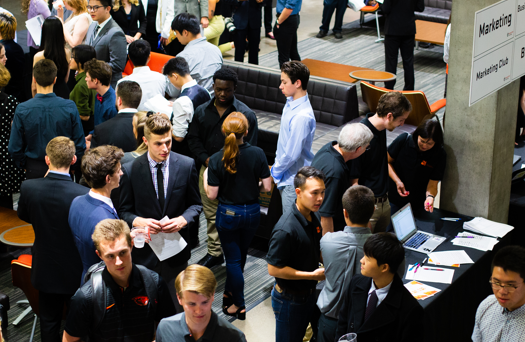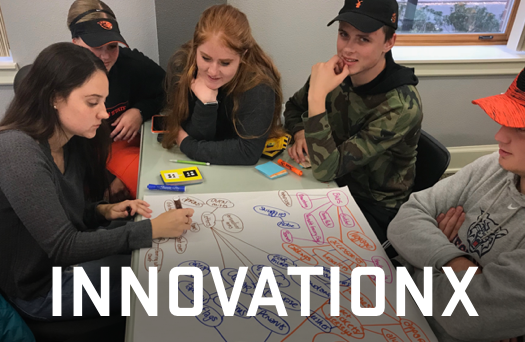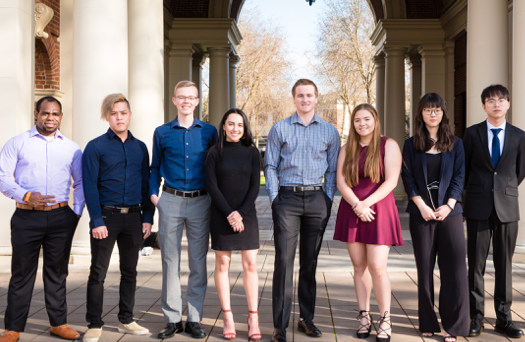From the Fall 2011 Oregon Stater
By Mia Isaacson
Did these things ever show up on your freshman to-do list?
- Help collect 100,000 pounds of food for the hungry.
- Drive across the United States to raise hunger awareness.
- Travel to Guatemala to help grant micro loans and teach business skills.
They made the list for Willen Sin, now a junior in business, who joined SIFE (Students in Free Enterprise) while taking an introductory business administration class as a resident of Weatherford Hall. Now vice president of development for SIFE, Sin’s latest effort aims to help a Corvallis-area business that hires people with developmental disabilities.
His one-word description of SIFE’s impact on his life at OSU: “Opportunity.”
Sin was recruited to SIFE in 2008 and was soon asked to join the group’s competitive speaking team, which attends regional and national events to showcase the group’s work.
“That’s kind of what pulled me in to becoming more involved, because I liked what they did,” he said.
Students started OSU SIFE in 2005 – joining an international network that has grown to 1,500 universities – so they could get real-life entrepreneurial experience while still undergraduates. After a halting start, the group has grown into a campus success story, drawing praise (and great attention for OSU) across the nation for its work to raise awareness of hunger and hunger-relief efforts.
OSU SIFE’s founders aimed to operate under sound business principles, be guided by a strong social conscience, be strictly student-run and have little formal attachment to the university. The business faculty was so busy developing the Weatherford Hall and Austin Entrepreneurship programs that SIFE was indeed almost fully detached from the university, and thus wholly dependent on students to develop their own leaders to replace founders who graduated.
“At that point it floundered,” Ilene Kleinsorge, Sara Hart Kimball Dean of the College of Business recalled, noting that new, wholly independent campus groups can have trouble during transitions between school years as their leaders graduate and move on. “It was only as strong as its current leaders.”
The students needed a mentor. Sandy Neubaum, originally hired by the College of Business to teach organizational behavior and human resources, stepped in.
Central to her effort was a course – the Business Administration 160 Series – titled “The Weatherford Way,” with this catalog description: “Building a foundation of entrepreneurial knowledge and gaining a competitive edge. Focuses on four important skills sets crucial to success in today’s global marketplace: teamwork, communication, creativity, and adapting to change.”
The version of SIFE Neubaum encountered included only three students, and two were graduating seniors. She met with Jennifer Villalobos, ’09, now an MBA student and then SIFE president, and the two regrouped and started recruiting.
“Only a small percentage of our students are interested in running businesses while focusing on school,” Neubaum said. “But, at the same time, we were noticing more and more that students want to do work that matters.”
BA 160 and SIFE are based on civic engagement and learning that business skills can be used to make the world a better place as well as to make money.
“The type of students that are involved in SIFE are ones that want to be active and engaged in their community,” Kleinsorge said. She describes the relationship between SIFE and the students as a win-win.
As a freshman, Kimberly Pendergrass, now a fifth-year senior in business and art history and SIFE’s vice president of programming, heard about the Austin Entrepreneurship Program while living in Weatherford. She enrolled in BA 160, where she met older students who sold her on the group.
“I was really excited to find a club that was looking for a broader outreach (and) that wasn’t hungry for attention or awards,” she said. “Those things come through as a result of what we do. But we do not shape what we do around getting awards.”
In May 2011, the OSU SIFE team traveled to Minneapolis for a national competition and placed in the top 20 out of more than 130 teams nationwide.
“That’s huge that all your hard work is recognized,” said Neubaum. “I knew they could do it. There’s no doubt in my mind that I work with some of the best students in the country.”
“The quality of students that SIFE turns out is really interesting,” Pendergrass said. “And you’ll see it reflected through regional and nation exposition. You will see highly motivated people who are motivated from within. There are kids who are problem solvers, who will find solutions from something you didn’t know existed.
“It really gets people unified under a cause of global social corporate responsibility.”
SIFE lets students choose their level of involvement, which lets them adjust as other demands ebb and flow.
“If you want to be involved every minute of every day, there is a place for you. If you want to be involved one day in a month, there is a place for you too,” Pendergrass said. The group selects its projects based on triple bottom-line accounting, taking into account people, profit and planet.
When SIFE’s national headquarters realigned its mission this past year, OSU SIFE followed suit, expanding to work on business models for Cornerstone Associates, a Corvallis-based organization that runs several businesses that provide supportive employment to people with cognitive mental disabilities.
“It’s local, and it gives you a great feeling,” said Neubaum.
The students also help teach financial literacy in the Corvallis area. SIFE students, with the assistance of Anissa Arthenayake, director of community education at OSU Federal Credit Union, reach out to local Title I schools – a designation given to schools with low socio-economic status – to teach prudent money skills.
“Pulling people out of poverty or changing behaviors later in life is really hard. So the best thing to do is to educate the next generation,” Pendergrass said. The curriculum’s success is measured through pre- and post-testing.
“We’ve seen knowledge grades go up to about 80 percent in the majority of classrooms, which is a huge, huge number,” said Sin, formerly the entrepreneurship initiative leader for the project.
Meanwhile, SIFE has never turned its back on the ever-present issue of feeding the hungry.
“We had already done a significant amount of work with hunger and received recognition,” Neubaum said. “That was something we wanted to continue with.”
OSU SIFE first got involved with fighting hunger through the Campbell’s Let’s Can Hunger Challenge in 2009 and has twice received national recognition for that work.
“SIFE has a three-fold mission in hunger: promoting hunger awareness, short term hunger relief and lasting hunger relief,” said Pendergrass.
Out of this mission evolved the Hunger Tour, which began in 2009. Six to eight students crossed the nation in a van looking at model hunger-relief organizations in different states. They stopped at food pantries, soup kitchens and farming programs. They pitched in while learning valuable lessons about what works and what doesn’t.
“There are really out-there, innovative solutions,” Pendergrass said. “What we found was that there are some programs with amazing organizational structures, and some with not so great structures. What’s happening is that there’s no communication between them.”
As SIFE students taught at Boys & Girls Clubs across the nation, they heard story after story from children who knew the pain of true hunger.
“A lot of kids do know first hand what it means to be hungry and go to bed without food,” said Pendergrass. SIFE members talked to children about healthy eating habits and helped them make healthy, inexpensive snacks they could replicate on their own at home.
Sin, who has participated in both of the annual hunger tours, said the work had an impact on him.
“I was able to see the world in a totally different perspective,” he said. “Being able to travel around and see people suffering was a real eye-opener for me.”
Neubaum uses the topic of hunger to get students engaged in her classroom.
“If you are going to have a conversation with students, almost everyone intuitively gets hunger,” she said. “They understand that, regardless of circumstances, everyone should eat.”
When the SIFE team started looking for a third project, all of the students wanted to do something internationally.
So, in the summer of 2010, students went to Guatemala to shoot a video to help a local NGO (nongovernmental organization) with its marketing. Students stayed with host families and became enamored of the small community. They wanted to do more.
SIFE has helped pay for a water filtration system for a coffee cooperative in San Miguel Escobar, Guatemala, with the help of Lowe’s Home Improvement. The newest project is a bakery to serve as a place of employment for students of a deaf school in a neighboring community. SIFE students want to teach entrepreneurship skills and use the bakery as a practicum site.
“It’s about building relationships,” Neubaum said. “It’s about understanding that it’s a duet. I never want my students to have the idea that you go in and you are going to save them. In reality students learn every bit as much. And that I think that is the moment that you recognize that this is what change looks like, (and) you change along with the community.”
SIFE expanded its focus this summer to go to Nicaragua and – they planned – eventually to Columbia. The focus is on making micro loans and teaching business skills. Micro loans involve small amounts of money that can be extremely effective in promoting entrepreneurship in economically depressed areas.
Kleinsorge sees parallels of idealism between the students she sees now and business alumni from past years.
“Most of our alums from years gone by have wanted to make a difference as well,” she said. “They wanted to make a difference in someone’s life, or in the life of the company … . There is a different perspective between ‘I want to make a difference’ and ‘I want to change the world.’”
Neubaum is proud of her OSU SIFE students.
“Overwhelmingly, it’s about the students,” she said. “It’s about the understanding that regardless of your age, you can change the world. It’s a powerful message. I can’t tell you how many conversations I’ve had with people and they say: ‘Your students are doing what? I had no idea.’”
Mia Isaacson, ’12, is a fifth-year senior in the College of Business, with a minor in Spanish. She has worked as an intern in OSU university marketing and advancement and has served as vice president for public relations for SIFE.








